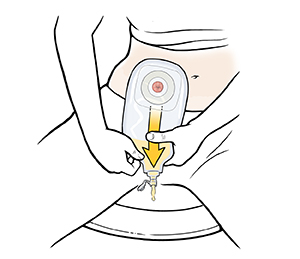You’ve just had a urostomy. As part of your surgery, a small opening (stoma) was made in your belly (abdomen). Urine and mucus drain from the stoma into a disposable pouch. You’ll need to empty your pouch when it gets to be about one-third full. The pouch is likely to become this full every 2 to 3 hours. Emptying your pouch keeps the pouch from bulging under your clothes. It also helps prevent leakage and odor. You will use a different collection system at night so you will not have to get up to empty the pouch
How to empty your pouch
To empty your pouch, follow the steps below:
Step 1: Empty the pouch.
-
Sit on or stand in front of the toilet. Put a layer of toilet paper in the toilet bowl to keep urine from splashing.
-
Pull your clothes away from the pouch.
-
Hold the pouch drain at the bottom of the bag over the toilet bowl.
-
Open the pouch drain so that urine flows into the toilet.
-
Empty all the urine and mucus from the pouch. While holding the pouch with 1 hand, slide the fingers of your other hand down the pouch. This will help empty any mucus from the pouch.
Step 2: Close the pouch drain.
-
Once you’ve emptied the pouch, use a piece of toilet paper to dry the tip of the drain. This will keep any urine or mucus from getting on your clothes.
-
Put the pouch drain in the “closed” position.
-
Wash your hands after emptying the pouch.


